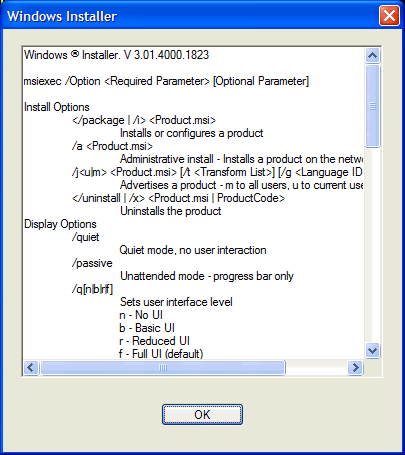

- INSTALL4J STANDALONE UPDATER COMMAND LINE SWITCHES INSTALL
- INSTALL4J STANDALONE UPDATER COMMAND LINE SWITCHES SOFTWARE
- INSTALL4J STANDALONE UPDATER COMMAND LINE SWITCHES CODE
- INSTALL4J STANDALONE UPDATER COMMAND LINE SWITCHES DOWNLOAD
Taverna is licenced under the GNU Lesser General Public Licence. Rm -rf ~/.taverna-commandline-astronomy-2.5-snapshotįind ~/.taverna-commandline-astronomy-2.5-snapshot/repository To verify, now the repository folder should be empty: mvn clean package Now copy and paste to add those artifactItem blocks within the beginng (or end) of the block in pom.xml. To check which edition you are building, verify these bits of pom.xml: taverna-commandline-$/repository/org/slf4j/slf4j-api/1.6.1 enterprise - core with all possible plugins.biodiversity - core + WebDAV + BioDiversit圜atalogue.bioinformatics - formerly maintenance, adds BioMart, BioMoby, Soaplab, corresponding default services and BioCatalogue.core - for any domain - general activities (WSDL, REST, Beanshell, Component, Interaction, etc) - also basis for the other branches (can be considered the ‘master’ or ‘trunk’ branch).Each domain-specific build extends the core branch by modifying the plugin set (and ensuring the repository folder is populated for those plugins), but may also modify configurations such as the default service sets. This repository have several “edition” branches, one for each domain-specific builds.
INSTALL4J STANDALONE UPDATER COMMAND LINE SWITCHES DOWNLOAD
In most cases you do not need to compile Taverna, instead you can download the official distribution for your operating system from the Taverna download pages.įor usage of this product, see the Command Line Tool documentation.

This is the build product for the standalone Taverna Command Line tool.
INSTALL4J STANDALONE UPDATER COMMAND LINE SWITCHES CODE
Each product includes their required code from the common Taverna source code, by retrieved the compiled JARs from the myGrid Maven repositories unless they have already been built locally with Maven.
INSTALL4J STANDALONE UPDATER COMMAND LINE SWITCHES SOFTWARE
You can think of a product as the last build step before having a downloadable/executable software distribution. This repository is a Maven source code trees that do not themselves contain any code, but which are used to assemble the distribution, add launchers and configurations files, and package this as installers. (c) Copyright 2005-2014 University of Manchester, UK Introduction here ya go.Taverna Command Line product build and installers I do hope no one walks as silly as me, but if you had also encountered the same mess up, well. I have now successfully created an installer. I should've just used the target folder itself. Apparently, it needs all the files inside the target folder generated by maven. So that's all my directory had - the jar file and the lib folder. I copied my dependencies into a lib folder via maven, then i put them into a directory along with my jar. In the tutorials, they had a separate lib directory which contained external libraries. So in install4j, you select a directory that would contain the files you would add to your installer. I just simply had to remove the Spring leftovers, and the boot-inf directory was gone. I'm no longer using Spring, but I still had some leftover Spring in my pom file, which caused it to put the files in a BOOT-INF directory when i package it to jar. Initially, like way way back, I tried using JavaFX with Spring Framework - unsuccessfully. : BOOT-INF/classes/inc/pabacus/TaskMetrics/TaskMetricsApplication (wrong name: inc/pabacus/TaskMetrics/TaskMetricsApplication)
INSTALL4J STANDALONE UPDATER COMMAND LINE SWITCHES INSTALL


 0 kommentar(er)
0 kommentar(er)
